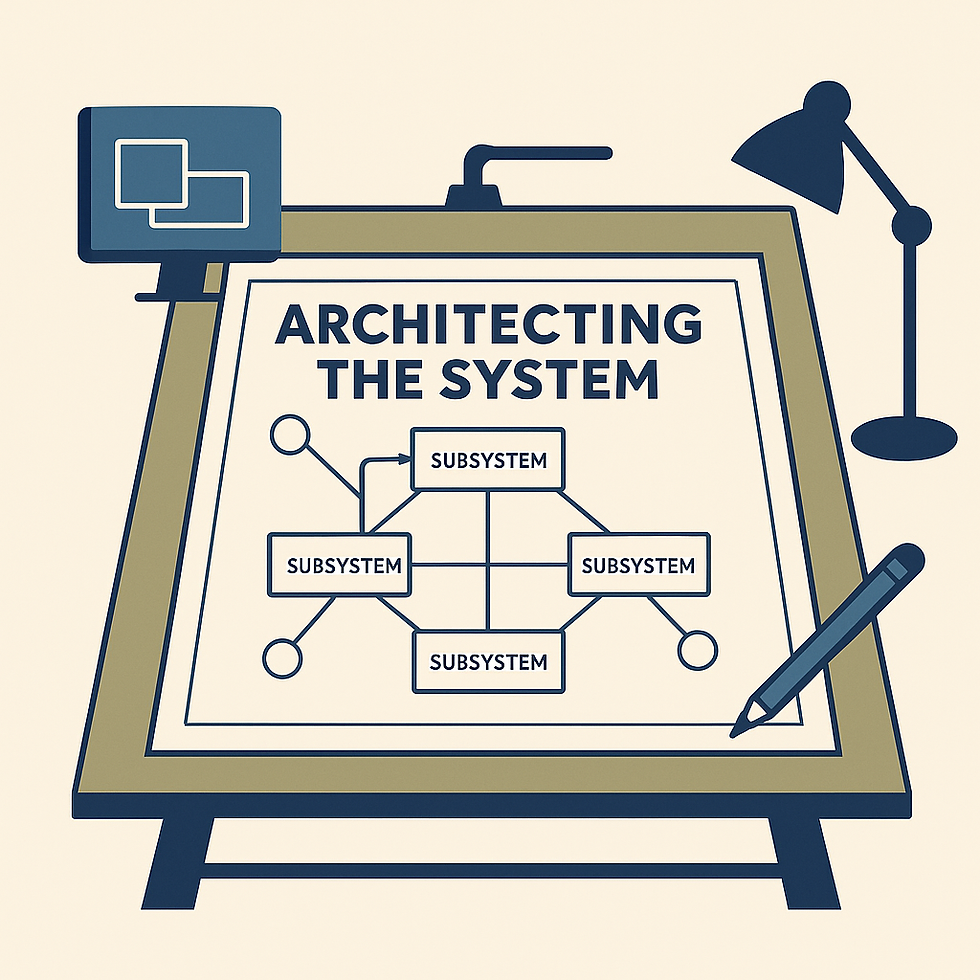#8 Interface Control and Integration Planning
- Vignesh Venkatesh
- Sep 22
- 3 min read
Updated: Oct 28
As systems engineers, we know that systems aren’t just built they’re assembled. And the seams where components or subsystems meet are the most common points of failure.
This step in the lifecycle focuses on making those seams explicit. It transforms high-level architecture and requirement allocation (see [Dispatch #7]) into concrete, testable, and owned interface definitions, backed by a strategy to integrate those elements predictably and safely.
Lifecycle Placement: This activity begins once architectural decomposition is complete and requirements are allocated. It feeds into Verification Planning and Integration Readiness activities.
1. What is an Interface?
An interface is a point of interaction between two separate system elements which could be hardware, software, humans, external systems, or the environment.
There are four classic types of interfaces in system engineering:
Interface Type | Examples |
Data (Information) | Protocols, APIs, serial links, CAN bus |
Energy | Power supplies, batteries, charging interfaces |
Human | Screens, buttons, maintenance access panels |
Mechanical/Physical | Mounting surfaces, enclosure seams, thermal coupling |
2. What Is Interface Control?
Interface Control is the discipline of defining, documenting, and governing the characteristics of an interface.
It ensures that:
All parties involved in development understand what needs to connect, when, and how
No assumptions are made about "how it should work"
Interfaces can be tested independently
Changes are traceable, reviewed, and managed
Without interface control, integration becomes an uncontrolled experiment.
3. Interface Control Document (ICD)
An ICD is the primary deliverable of this phase. It is the agreed specification for an interface between two entities.
Key Fields in a Professional ICD:
Field | Purpose |
Interface Name & ID | Unambiguous reference |
Direction of Flow | Who initiates / responds |
Protocol | HTTP, Modbus, JSON, analog voltages etc. |
Data Format | Field definitions, ranges, units |
Physical Layer | Connector, pinout, voltage spec |
Timing | Latency, retry strategy, update rate |
Error Handling | Timeout, failure recovery, alerting |
Ownership | Who builds it, who tests it |
Test Access Points | Logs, diagnostic ports, test hooks |
Minimum Maturity for Engineering: All critical ICDs should be defined at L2 maturity protocol plus behavior before integration begins.
4. Integration Planning
With interfaces defined, we prepare for planned, staged integration not big-bang assembly.
Key Concepts:
Integration Sequence Plan:
Defines which subsystems get brought together, in what order, and what each milestone should verify.
Interface Readiness Mapping:
Confirms that both sides of each interface are ready, including hardware, firmware, and test tools.
Integration Test Environment:
Lab rigs, emulators, or virtual environments used to validate interfaces before full deployment.
5. Dependency and Ownership Management
Interface success depends on ownership clarity and inter-team coordination.
Use a RACI Matrix:
Role | Description |
R (Responsible) | Builds the interface |
A (Accountable) | Ensures delivery and test success |
C (Consulted) | Provides specs or constraints |
I (Informed) | Needs visibility of design or changes |
Example: The Mechanical Team is Responsible for lock housing dimensions. Software Team is Responsible for interpreting limit switch signals.
6. Interface Risk Identification
Interfaces carry failure modes mismatched expectations, bad timing, overloads, or unclear error recovery. These must be assessed early.
Use FMEA (Failure Mode and Effects Analysis) to:
Identify likely failure points
Assess severity and detectability
Plan mitigations or redesigns
Risk Examples:
Interface | Risk | Mitigation |
Power Bus | Ripple causing reboot | Add voltage regulator + capacitor |
SMS Gateway | Provider downtime | Implement retry buffer and alert logic |
Solenoid Lock | Jamming during actuation | Add mechanical feedback sensor |
7. Deliverables from This Step
Deliverable | Purpose |
ICD Suite | Defines all system/subsystem interfaces |
Integration Plan | Documents test order and dependencies |
RACI Matrix | Ensures accountability per interface |
Dependency Map | Clarifies readiness paths for components |
Interface Risk Register | Links risks to interface control points |
These deliverables become part of the Integration Readiness Review (IRR) pack.
8. Exit Criteria for Interface Control Phase
You’re ready to proceed to physical integration when:
All ICDs are at L2 maturity (protocol + behavior)
Each ICD has assigned ownership and test responsibility
Integration sequencing is defined and agreed
All interfaces have test access plans
Interface risks are mitigated or under control
Locker System Example
LTE Module ICD defines HTTPS endpoint, response codes, timeout policy
Lock Solenoid ICD defines 12V ±5% power spec, actuation current, return spring feedback
Integration plan sequences LTE→Controller→Solenoid in test rig before site deployment
Closing Reflection
Interface control isn't just documentation it's engineering discipline that turns architectural structure into testable, integrable, traceable subsystems.
Handled well, integration becomes an engineering checkpoint.Handled poorly, it becomes a minefield of rework.
Next : Verification and Validation Planning
We’ll shift focus from how things connect to how we prove they work:
Writing verification methods
Building the V&V matrix
Mapping test plans to contractual needs
Handling safety-critical test scenarios



Comments